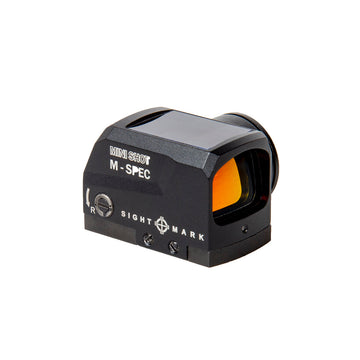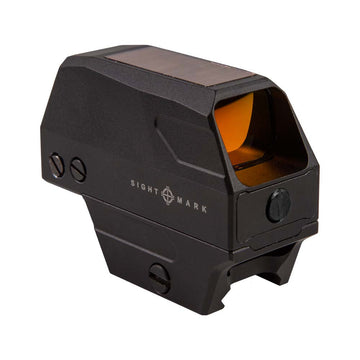Though it may seem a bit overwhelming at first with how many red dot sights there are to choose from, when it comes down to it, there aren’t really that many differences in red dot and reflex sights. Picking a red dot sight is easier than choosing a magnified riflescope—which can feel like the options are endless. After breaking down a few features, buying a reflex sight should be a simple process.

What Are Red Dot Sights Good For?
Red dot and reflex sights are relatively simple, intuitive aiming tools and after deciding on how much you want to spend (your budget) and the type of reflex sight you want (open or tube), which features suit your needs—
size, type of illumination, weight, construction, etc.—it will come down to deciding which size dot is best.
Good for rifles, pistols and shotguns, dot sights are a highly effective aiming tool for CQB, close to medium ranges, competition and self-defense. The biggest advantage of a red dot over any other optic or sight is the ability to acquire and hit a target incredibly quick. The size of the dot directly relates to how quickly you can locate the dot in the unit’s head’s up display and how much target area the dot covers. Both these things can significantly affect your accuracy.
Top Red Dot Sights from Sightmark
Understanding MOA in Red Dot Sights

The illuminated red or green dot of a red dot/reflex sight is measured in MOA—minutes of angle, a unit for angular measurement of a circle. 1 MOA equals approximately 1 inch at 100 yards. A 2 MOA dot would appear 2 inches wide at 100 yards, and so on. Therefore, the smaller the MOA, the finer the dot—and the more precise your aiming can be at distance.
Small vs. Large Red Dot MOA: Which Is Right for You?
Smaller dots—1 to 2.5 MOA—are ideal for precise shots at longer distances. These are commonly used in tactical and competition settings where precision matters. However, they can be harder to pick up quickly, especially in bright environments or for those with vision challenges.
Larger dots—4 to 8 MOA—are faster to acquire and best suited for close-range shooting, such as self-defense, steel competition, or hunting fast-moving targets. These dots may sacrifice precision for speed but shine in fast-paced scenarios.
Popular MOA Sizes and Their Applications
1 MOA dots are typically found on high-precision red dots and often paired with a 60 MOA circle to aid in acquisition. These are great for long-distance shots but require good eyesight and steady aim.
3 MOA dots strike a balance between speed and precision, making them the most popular for both self-defense and competition. A 3 MOA dot is easy to see and doesn’t obscure too much of the target even at mid-range distances.
5 MOA and larger are great for handgun use or CQB (close quarters battle) scenarios where target acquisition speed is critical. These sizes are also beneficial for shooters with astigmatism or limited vision.

How Sightmark Designs Its Red Dots
We designed the Ultra Shot and earlier red dot models based on available dot sizes and market feedback. Since then, we’ve adopted innovations like solar technology, improved battery life, and reticle customization.
About five years ago, we asked AR15.com and Sightmark Pro Staff members which reticles they preferred. Sightmark Product Development Director Jonathan Horton explains, “Most of our red dots are 3 or 5 MOA which is easy to acquire and still have on-target accuracy at 50 or 100 yards, even with a magnifier. Going bigger is good for short range but you’re covering a lot of your target anything over 50 yards. If we do a smaller aiming dot than 3, it does provide better accuracy out to 100 but we usually design a larger circle-dot around the dot for better acquisition at close range.”
Who Uses Red Dot Sights?
Most shooters purchase a red dot sight for its original intention—quick target acquisition in a self-defense situation. However, red dots are also increasingly popular among:
- Turkey hunters needing fast target visibility
- Steel and speed competition shooters
- Home defense setups
- AR users and tactical rifle setups
- Handgun carriers and concealed carry pistols
At the end of the day, choosing the size of the illuminated dot reticle depends on your primary use and the firearm you're mounting it to.
What dot size do you like and why? Tell us in the comment section.
Learn How to Use a Red Dot Sight
Shop Sightmark Red Dot Sights
Frequently Asked Questions
What are red dot sights used for?
Red dot sights are designed for quick target acquisition and are ideal for close to medium-range shooting. They're commonly used for self-defense, hunting, competition, and tactical applications.
What’s the difference between red dot and reflex sights?
All reflex sights are red dot sights, but not all red dot sights are reflex sights. Reflex sights usually have an open design, while some red dots come in a tube-style housing. Both project a red dot as an aiming reticle.
What does MOA mean in red dot sights?
MOA stands for "Minute of Angle." It refers to the dot’s size as seen on target. For example, a 2 MOA dot covers 2 inches at 100 yards. Smaller MOA means more precision; larger MOA means faster acquisition.
Which MOA size should I choose for a red dot?
Choose 1–2 MOA for precision shooting, 3 MOA for a balance of speed and accuracy, and 5–8 MOA for fast, close-range shooting or for shooters with vision issues like astigmatism.
Are larger dots easier to see?
Yes. Larger dots like 5–8 MOA are quicker to pick up in the sight window, which is beneficial for close-range and defensive shooting scenarios.
What is the most common dot size for red dot sights?
3 MOA is the most popular size because it provides a good balance between speed and precision, making it ideal for a wide range of shooting situations.
Can I use a red dot sight on a shotgun or pistol?
Absolutely. Red dot sights are highly effective on shotguns, pistols, and rifles. They're especially popular for AR platforms and defensive handguns.
What are the benefits of solar-powered red dots?
Solar-powered red dot sights extend battery life by supplementing energy with solar input. They can operate longer and remain functional even if battery power runs low.
How does dot size affect accuracy?
Smaller dots (1–2 MOA) offer greater precision for longer distances, while larger dots (4–8 MOA) are faster to acquire but may cover more of the target, reducing precision.
Who typically uses red dot sights?
Red dot sights are used by hunters, tactical shooters, competition shooters, home defenders, and concealed carry users due to their speed, simplicity, and versatility.







8 comments
What do you recommend for a AR12 for self defense and a Beretta 9 mm model 92FS for self defense.
I am looking for a dovetail mount and green dot sight (5 to 6 moa) that will fit on my older Glock 17 gen 2.
Greetings, Mr. Rego!
You asked for a red dot recommendation for your M&P Shield and Sig P365 pistols. First, you should know that red dots are only mountable on pistol footprints they’re compatible with. Now, if your pistol slides are optics-ready, it’s likely that both the M&P Shield and Sig P-365 will have RMS-C footprints.
If your pistols are optics-ready with this particular cut, I highly recommend the Mini Shot A-Spec M3 Micro or the Mini Shot M-Spec M3 Solar. Both have very long battery lives and auto-brightness reticles that become brighter or dimmer depending on your lighting environment. I sincerely hope I’ve been helpful. Please feel free to ask any questions you might still have!
I am looking for a red dot optic for both my older M&P Shield and my Sig P-365. I mostly practice at shorter distances – maybe 20 yards max. I would appreciate any advice. Thanks!
Here at Sightmark, we believe in catering to our customers’ specific needs. You asked what type of red dot would be good for your Browning BPS 12ga. We recommend the Mini Shot M-Spec FMS Reflex Sight. This compact but powerful reflex sight is larger than a micro red dot but smaller than an ultra shot. It also sits low to the bore, making it perfect for shotguns like yours. This optic is compatible with all Picatinny mounts, but if your rifled barrel has a dovetail sight, we recommend buying an adapter for compatibility.